This article contains massive SPOILERS for each film in the PHANTASM series.
PHANTASM was never supposed to be more than a stand-alone horror film. Despite the reported two plus hours of deleted scenes and alternate footage shot, writer/director Don Coscarelli edited his sprawling tale down to a tightly wound ninety minute nightmare that spoke volumes about the fears Mike (A. Michael Baldwin) had of death and abandonment. Ending with a heartbreaking scene between Mike and Reggie (Reggie Bannister) as Mike accepts his fate as the lone survivor of his family before the gut punch of the The Tall Man (Angus Scrimm) appearing in Mike’s room to confirm that you can accept loss, but you cannot outrun death, the film was narratively and thematically wrapped up. So why are we getting a fifth PHANTASM film 37 years after the original?
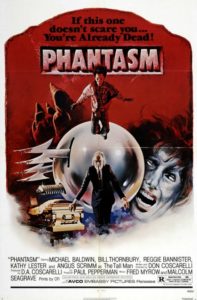
Not surprisingly, the answer is mostly that they are profitable. While we are not talking the kind of financial returns of major horror franchises like FRIDAY THE 13TH, A NIGHTMARE ON ELM STREET, or the even the SAW films, the PHANTASM sequels were a source of semi-dependable income for a staunchly independent filmmaker like Coscarelli. It is a harsh truth of the film industry that some of the most talented directors have difficulty getting projects off the ground and need to occasionally return to the well for what they know will get a green light.

But despite the mercenary roots of the PHANTASM sequels, the films themselves have overall been dignified, textured, and rewarding for viewers who can roll with their absurd punches. With the exception of PHANTASM II, Coscarelli kept his core cast together. As a viewer, the experience of watching the characters age in real time felt like you were catching up with old friends every few years. And while the plots of the films became even more abstract with plot twists that came up to the edge of being soap opera-like in places, the affection that Coscarelli and the cast had for Mike, Reggie, Jody (Bill Thornbury), and even The Tall Man was palpable.
The decision to carry on the story after the first film required some reverse engineering by Coscarelli. Since the first film ended with Mike’s abduction (and presumed death), the decision was made to start the second film from that dramatic end point. As Reggie stepped into his role as the film’s heroic center, rescuing Mike from the villainous dwarves, diving out the window of the house as it exploded in a massive fireball while The Tall Man looked on before calmly making his escape, it felt like the series had jumped the shark in the first five minutes of its second film. Coscarelli immediately undercuts that crazed opening by revealing that it was a just a continuation of Mike’s nightmare about the death of his family. It is a ballsy narrative trick that should not work, but Coscarelli pulls it off by making it stay of a piece with the nightmare logic established in the first film.
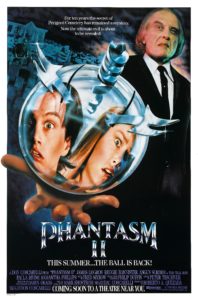
Despite getting away with that audacious opening, PHANTASM II is the closest the franchise comes to falling apart. This comes from the fact that—unlike the other films—it was financed by a studio (Universal) that reportedly required Coscarelli to recast either Mike or Reggie. With his hand forced, Coscarelli brought back Bannister as Reggie. James Le Gros was brought in as the young adult version of Mike (a then unknown Brad Pitt also read for the part).
LeGros—whom, it should be noted, has developed into a very good character actor—was miscast. Not only did he look nothing like Baldwin, his performance was tonally off. He played Mike as slightly spooky and aloof. Where Baldwin was prickly and frustrated, he was also earnest and his skinny build, slightly geeky persona and looks made him a fun underdog. Le Gros was classically handsome and built like an athlete. The disconnect between the two versions of the character was almost too much to take.
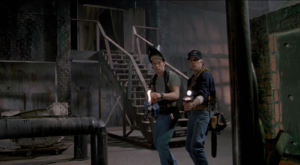
What the casting of LeGros did accomplish as a positive was focusing the films away from Mike and on Reggie. Bannister, while continuing his work as a comic relief in the films, gave Reggie a heroic soul that translated into a leading man who looked nothing like a leading man. The films had a lot of fun with this dichotomy starting with Reggie’s doomed romance with Alchemy (Samantha Phillips) that had her obsessed with his bald head.
Despite the introduction of a couple of new characters in Liz (Paula Irvine) and a tortured Priest (Kenneth Tigar) who is reluctant to stand up to The Tall Man, the focus of PHANTASM II is on how Reggie replaces Jody (whose absence in the film is palpably felt) as Mike’s older brother. Losing his family to The Tall Man in the first act of PHANTASM II, Reggie is in the same boat as Mike, deepening their bond. The absence of Baldwin is a major misstep, but Bannister helps fill the void and keeps the film watchable, even as it resonates far less than any of the other sequels.
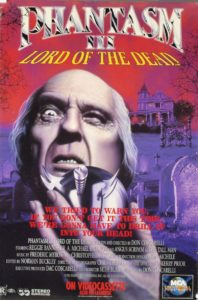
OLYMPUS DIGITAL CAMERA
Having seen how accepting audiences were of the fudging of continuity between the first two films, Coscarelli really threw caution to the wind with the opening of PHANTASM III (A.K.A. PHANTASM: LORD OF THE DEAD). Once again, despite a lengthy amount of time between the sequels (nine years between PHANTASM and PHANTASM II, six years between PHANTASM II and PHANTASM III), the opening of PHANTASM III picks right up from the end of PHANTASM II.
Again using the trick of never exactly showing a character die, Reggie turns out to only be wounded when the hearse carrying Mike and Liz leaves him behind. As though realizing the weak points from PHANTASM II, Coscarelli takes advantage of the freedom of being an independent production again by bringing Baldwin back as Mike. With some clever shooting, editing, and acting by Baldwin and Bannister, the ending of PHANTASM II is recreated in painstaking detail to insert Baldwin in place of Le Gros.
Like PHANTASM II, PHANTASM III opens with a bang. Reggie is revealed to have survived Alchemy’s attack on him. But just as the audience is adjusting to seeing Baldwin back as Mike and processing Reggie’s survival, the hearse crashes spectacularly. Reggie somehow recovers the awesome four-barreled shotgun that he discarded in the third act of PHANTASM II (continuity be damned), Liz is unceremoniously reduced to a cameo as a bloody, severed head (cutting basically all ties with the studio-backed second film), and The Tall Man betrays a hint of a new motivation by saying, “I don’t want him in pieces,” when he backs off from Reggie’s threat of a double suicide with Mike via grenade.
The revelation that The Tall Man had plans for Mike beyond simply shrinking him down to a dwarf and sending him back to his home planet like everyone else is nearly lost in the chaos of the opening. To that point in the films, Mike had been nothing more than a nuisance for The Tall Man. It was he and Reggie who had been doing the chasing while The Tall Man wiped out towns and emptied the cemeteries. At the most, he seemed to regard Mike as foe to be toyed with for as long as he was amused. But with that one line, Coscarelli revealed a whole new plot line for the films that would carry through the end of the fourth film (and presumably picked back up in the upcoming PHANTASM: RAVAGER). That the new plot felt organic in the way it came about had much to do with Baldwin back in the role of Mike.
It also helps that Reggie seems as flummoxed by The Tall Man’s revelation as the audience. His confusion continues with Thornbury returning to the films as Jody’s ghost/soul trapped in one of the flying silver death spheres (a plot twist that I somehow take as seriously now as a 42-year-old as I did when I was 21). Bringing Jody back in such a way is both tragic and oddly heartwarming. While it is upsetting to learn that Jody was indeed snatched by The Tall Man, it is also a nostalgic kick to see him interacting with Reggie and Mike again. But while Mike’s sudden importance to The Tall Man comes off as almost inevitable and makes sense in the nightmare logic world of the PHANTASM films, Jody’s reappearance as a sphere is the first real giveaway that Coscarelli is largely making up things as he goes along.
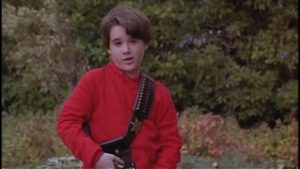
This feeling of flying by the seat of the pants continues with the introduction of Tim (Kevin Connors), an adolescent kid who is the lone survivor of his town’s demise at the hands of The Tall Man. Living in a large house that he has bobby-trapped against all invaders, his part of the story plays out like a surreal HOME ALONE sequel where the cartoon violence results in bloody fatalities. Considering that PHANTASM III came out in 1994, two years after HOME ALONE 2: LOST IN NEW YORK, it cannot help but feel like Coscarelli is trying to play to some of the cinematic trends of the time. Of course, Tim could simply be meant to remind audiences and Reggie of Mike when we first met him in the original PHANTASM. Both boys are scrappy, resilient, and have a little MACGYVER in them when it comes to creating traps and weapons out of random materials.

While Tim can be explained away with the Mike comparison, the same courtesy cannot be afforded the character of Rocky (Gloria Lynn Henry). With her military-like wardrobe, hi-top fade, and muscled physique, her presence is impossible to align with any other character in the films. It is possible that Coscarelli was trying to tap into the African-American audience that had just recently helped make hits of films like BOYZ N THE HOOD and MENACE II SOCIETY. I suppose the charitable way to look at Rocky is an attempt by Coscarelli to bring more diversity to a franchise that had been overwhelmingly white to that point. Whatever the case may be, it is hard to ignore how much of a caricature she initially is as she spouts what distinctly sounds like a white guy’s idea of how a black woman talks. Thankfully, Henry’s smirking performance and chemistry with Bannister makes her a welcome presence in the film. Rocky even becomes Reggie’s only would-be love interest to neither die nor turn out to be a minion of The Tall Man (Although she does drive off in a stolen hearse, so who knows?).
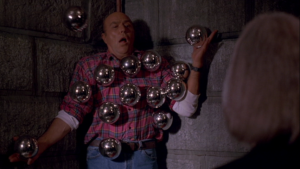
While Reggie’s storyline with Tim and Rocky overcomes some awkward physical comedy bits to become an entertaining, straightforward action/horror film, the storyline between The Tall Man, Mike, and Jody appears to be a lot of wheel spinning. Jody-as-sphere turns against The Tall Man to help Mike and Reggie, and is damaged by The Tall Man as punishment, requiring him to appear to Reggie in dreams where he gives cryptic advice while Mike freaks out, wondering why he is so important to The Tall Man’s plans. It is not until the shocking revelation in the third act that Mike has a sphere for a brain, that Jody’s warnings and The Tall Man’s obsession with Mike makes some sense (but not complete sense; this is a PHANTASM movie, after all). Is Mike an alien, a weapon, or something else? He is clearly important to The Tall Man, but how or why is not ever answered (so far). But what is important at that moment is that Mike and Reggie realize that Mike has never been human. In one of the most emotional moments in the series, after The Tall Man has seemingly been killed (yet again), Mike walks away from Reggie, accompanied by Jody. Mike no longer sees himself as human and has to be separated from Reggie, his oldest friend, for fear of harming him.
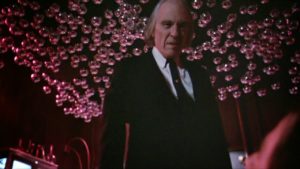
Perhaps the most notable moment in PHANTASM III is not what is revealed about Mike, but that The Tall Man is shown exiting the interdimensional gate to take the place of the previously destroyed version from PHANTASM II. This a major question answered in a film series that thrives on leaving most important details unexplained. It is also an answer that Mike and Reggie do not know, heightening the sense of doom for our heroes that they can never win. As The Tall Man says to Tim and Reggie, after reappearing at the very end of PHANTASM III, “It’s never over!”
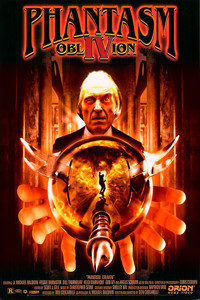
The idea that “it’s never over” makes sense for a horror film franchise; especially a franchise like the PHANTASM films where just as much of the story is pieced together in the editing room as is scripted before pre-production. Of course, it is when Coscarelli adjusts the audience’s expectations to the idea of a series of films that will never end that he presents PHANTASM IV: OBLIVION as an apparent conclusion to the series.
Released in 1998, OBLIVION continued the trend of the sequels mirroring the era in which they were produced. PHANTASM II contained the large set pieces, grotesque makeup effects, and sense of the fantastic that the NIGHTMARE ON ELM STREET films were known for at the time. PHANTASM III had its odd HOME ALONE-inspired subplot, and OBLIVION was on the forefront of DIY-horror films with a small cast and limited locations.

Paring the story down to the essential components of Mike, Reggie, Jody, and The Tall Man, Coscarelli reached back to the first film and its treasure trove of unused footage. The move was inspired as much by the meager budget Coscarelli had to work with as story requirements. But much the same way that PHANTASM was a masterpiece created in the editing room, OBLIVION‘s budgetary limitations and reliance on old footage to pad out the film to feature-length running time led to a moving, shocking, and honestly unsettling sequel.
Once again doing away with extraneous characters from the previous film, Tim and Rocky are not even killed off. They simply cease to exist, even though the film begins right from the end of PHANTASM III. At this point in the films, the disappearance of two supporting characters is hardly worth worrying about, especially when series continuity has always been fluid at best. That is the beauty of how the films embraced nightmare logic right from the start.
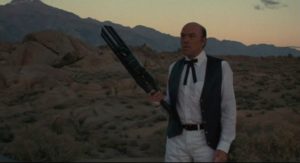
What is surprising about the old footage used in OBLIVION is how little of it is actually filler. Sure, Mike’s remembrance of a summer day from his childhood just to use a clip of him sneaking ice cream out of Reggie’s truck could be viewed as pure padding, but it serves as a reminder of how much has changed for these characters since the first film. To contrast a suicidal, thirty-something Mike sitting in the back of a hearse in the desert as he pens a goodbye letter to Reggie with the carefree kid from the first film hits emotionally harder than expected.
The best use of the old footage is a scene where The Tall Man has been tricked and is hanging from a noose in a tree (how he ended up there and how this scene would have fit in the original film makes my head hurt to consider). In the present day, Mike is strangling at the end of his own noose, having tried to kill himself. The idea that he would remember a strange dialogue between himself and The Tall man as his life is draining makes sense in that moment. It is a sad implication that at the apparent end of his life, Mike is trying to figure out how he got to this point.

For as much as OBLIVION is talked about for its use of old footage from PHANTASM, the most impressive sequence in the film is a new one as the origins of the inter-dimensional gate and The Tall Man are revealed. Scrimm gets to do double-duty as a kindly old southern gentleman named Jebediah Morningside (his name connecting back to the Morningside Cemetery from the first film), an inventor who created and opened the gate in the 19th century. Of course, old Jebediah stepped through the gate and returned as The Tall Man. Whether it was simply an alien presence that took over his body or Jebediah who turned evil is not explained.
And you know what? The Jebediah Morningside question does not need to be explained. Through four films, Coscarelli managed the trick of answering some questions while asking new ones that may or may not eventually be answered. It worked as a way of keeping the audience coming back for each film while the main characters went through a lengthy journey to learn the same lesson over and over again: you cannot escape death.
The ending to OBLIVION seems to make that theme explicit with what felt like an actual, concrete ending to Mike’s story. Thinking he has finally destroyed The Tall Man once and for all with his own homemade sphere and bomb (twenty years on and Mike is still the resourceful kid), Reggie and Mike are finally let in on the secret that the audience was told in PHANTASM III when a new Tall Man immediately steps out of the interdimensional gate. Helpless to stop him, Reggie can only watch in horror as The Tall Man pulls the sphere from Mike’s head and disappears back through the gate. Mike tells Reggie he is dying and Reggie, ever the hero, charges through the gate into the unknown as the audience gets a close up of Mike’s eye as his pupil dilates. Coscarelli then hits the audience with one final piece of old footage: Mike and Reggie riding along quietly in Reggie’s ice cream truck when layered over the soundtrack is Mike’s final words: “I’m dying, Reg.” Reggie flinches and looks around before asking Mike if he heard anything, to which Mike responds, “It’s just the wind. Only the wind.” They drive on into the darkness and a cut to the end credits. No final appearance of The Tall Man, no smash cut to credits as the goose bump-raising PHANTASM theme plays. Just silence. Crushing. Absolutely crushing.
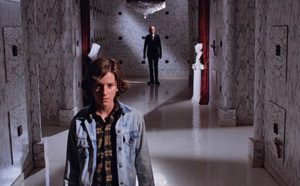
I try to marathon the PHANTASM films with a friend every couple of years. What I notice each time is how my initial feeling about each film remains unchanged. The first film is a masterpiece that sets up the tone of nightmare logic that you have to accept as an audience member for the films to work. If you sit there and nitpick the details and narrative leaps made without explanation, you are not going to enjoy it. But if you get on Coscarelli’s wavelength, you will be rewarded with one of the most intensive and heartbreaking emotional arcs in horror movie history. Who cares if characters disappear between films without explanation? Who cares that the ’71 ‘Cuda keeps showing back up in each film, despite being wrecked/blown up in the previous films? Who cares that Reggie’s four-barreled shotgun reappears without explanation after he tosses it aside in the second film? Why do Jody and The Tall Man age over the course of the films when they are supposed to be something other than human? Who cares? Where the hell did Myrtle (Myrtle Scotton), the housekeeper, come from and where did she go? Who cares? Where did Reggie get his ice cream man suit in OBLIVION? Once again, who cares? All that matters is the emotional journey that Mike and Reggie go through and all these other details are inconsequential. Coscarelli learned that in the first film and it is knowledge that freed up the films to go down surreal alleys without having to explain or justify them beyond adding a bit of character development or bolstering the outsized legend of The Tall Man’s villainy.
Despite how much OBLIVION feels like the proper ending of the PHANTASM story, I still find myself excited to learn what Coscarelli and new director David Hartman have in store for RAVAGER. After all, the first film had what seemed to be a concrete ending and Coscarelli managed to frame it in such a way to continue the story for three more films. Not to mention, I want to spend just a little more time with these characters. With Scrimm’s passing after filming had been completed, RAVAGER will certainly be the final film in the franchise. I have faith that everyone involved will bring it all to a satisfying close that still leaves several questions unanswered. It would not be a PHANTASM film without those ambiguities.
Tags: Don Coscarelli, Phantasm, Phantasm II, Phantasm III: Lord Of The Dead


That was the best Phantasm article I’ve ever read in my life! Thank you so much!
Amazing write-up! Just caught this years later, but loved the analysis. Thank you